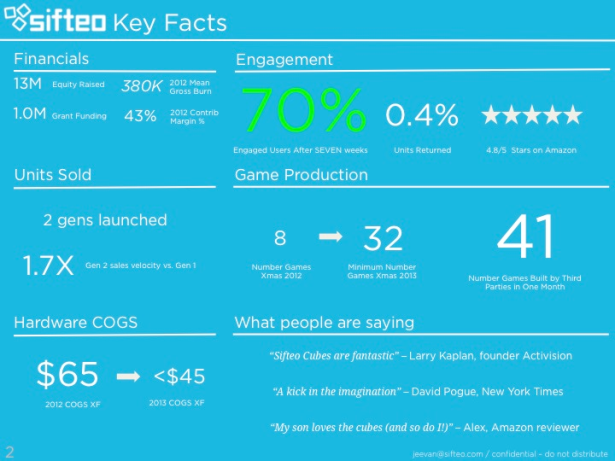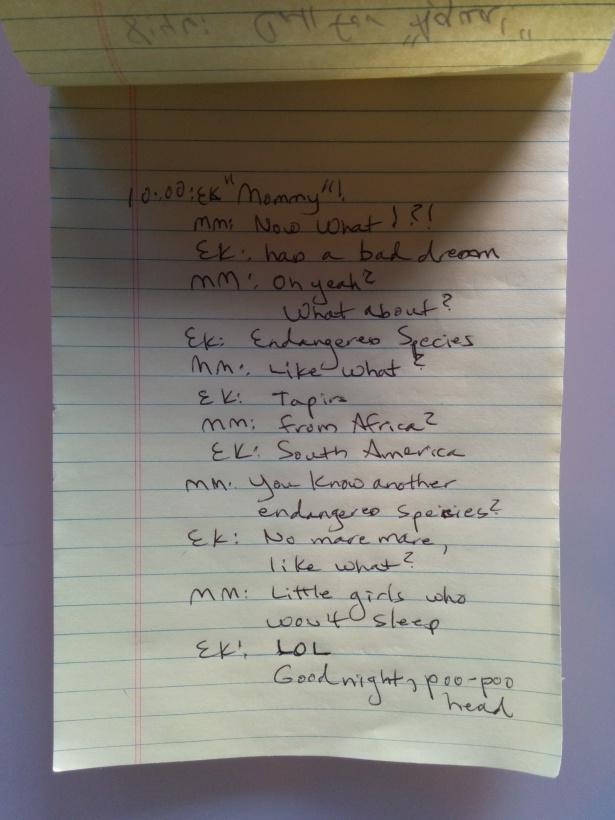THE POINT OF THIS POST Acquisitions are so secretive and there is so much B.S. surrounding them publicly. I hope sharing specific details (mixed with some advice) will be interesting reading to all you entrepreneurs out there.
FAIR WARNING This is a meandering tour that jumps around, skips big chunks, circles back, dives forward. I decided it was better to put the story down and get it out than it was to perfect it. A cop-out approach to writing? Almost certainly.
But done > not done.
Hey, guess what, we (Dave Merrill and I) sold our (first) startup, Sifteo! First off, I am thrilled to be joining our acquirer, 3DRobotics – we’re going to help make flying robots. This is a childhood dream (ROBOTS), and a perfect home for our company’s assets and team. I can’t say much about what we are doing with our technology or what we are working on, but it should be fun.
I’ll focus on our own acquisition scenario, which is something like this: your company accomplished a lot, made millions of dollars, but you ultimately determined the company’s current path was not going to get you to the Big Time. You saw the wall speeding toward you (or is that you speeding toward the wall?). So you hit the reset button, cut back, and starting work on the next thing with the remaining cash.
I’ve heard the most common outcome for startups is outright failure, closing the doors: 9 out of 10. Of the last 1? I guess 0.2 out of 10 truly kick ass. Sifteo, I suppose, falls into the last 0.8 out of 10.
This story begins near the end.

Sifteo cubes, generation 2
Our story begins last summer, in 2013. We had failed to raise a needed round of cash, and the cost of running our business was skyrocketing. We had built and shipped two generations of Sifteo cubes, a game system made up of intelligent little blocks. But we radically underestimated the cost of game production. Hardware is expensive for sure, but as a percentage of our expenses, games production was far and away the biggest ticket item.
More important, we just weren’t selling enough product. Why? Well, while we were undoubtedly a critical success (loved by the press, the industry, and education-minded folks), Sifteo cubes weren’t making our customers happy enough! Our NPS scores were off target.
(Some other time I’ll break down exactly why we failed to really establish a growing customer base, but that’s for another post. That fact has a lot to do with the challenge we faced raising a round.)

A slide from our fundraising try. Seems like it should have worked, right? But it didn’t.
Bottom line was: we had to do something new, or go out of business.
When to sell? If you have less than six months of cash, you are in bad shape.
As we made the call to reset in the summer of 2013, Dave and I and the board set a clock for ourselves – six months to be locked and loaded on the new thing, and about nine to launch it (in our case, fire up a crowdfunding campaign for a new hardware product). We’d have four to five months of runway after that, minimum – and likely longer – since we would have gotten revenue in the door at launch. Our investors were also super supportive so this felt like a reasonable strategy – they’d likely re-up if things were going well.
This timeline wasn’t set in stone, but we put this expectation on ourselves. If we weren’t hitting our timeline, we’d have to start shopping ourselves around, at about the six month mark. We just wouldn’t have enough cash to launch a new product by that point.
Sounds pretty basic, and it is. And as you’ll see, even in theoretically ideal circumstances, a sale will take six months.
Companies are bought, not sold.
December – the six month mark – rolled around, and if we were following our plan to the letter – it’d be time to start shopping the company around. Ugh. We were actively working on new product ideas and were not mentally ready to begin the shopping process.
But wouldn’t you know: in late November, a friend from corp dev at HOT_SF_COMPANY sent us a note.
Hey Dave,
How are you? Just reaching out about Sifteo – some folks over here noticed what you’re doing and were impressed – would love to catch up if you have a chance this week – lemme know man!
(Dave is Sifteo’s co-founder.)
Wow! Good timing. Off to the races.
Frankly, I’m not sure exactly how we would have proceeded without inbound interest.
If you have to shop your company around proactively, that seems … not good. Chalk it up to our reptile brains, but people (buyers) are interested in things that seem scarce – and if you are shopping yourself, you are by definition not scarce.
Tangent #1: Suggestions on making acquirers come to you.
First, make your company interesting to the outside world, especially to potential buyers, even if you are not “killing it” (even in fact if you are getting killed by it) – be out there in your relevant tech community at events, be good to people and build your reputation the right way, have a cool product that gets noticed in the press. Do this from day 1 of your company.
Second, revamp your site once you’ve made the decision that you might want to sell. You could focus on team, but if you don’t want to – still just generally reboot the site. This is a signal that you are alive and up to something, but perhaps are open to an offer. A clearly stale site is no bueno. And by the way, stale sites are really obvious. A stale site means you could be easy pickings, or more likely, soon to be in the deadpool. Don’t send that signal.
Third, go to a fancy college such that the corp dev guys at Big Co’s were in your freshman dorm.
I’m unfortunately not joking about that last point. A corp dev person’s job is to essentially know people from college.
There is no going back.
So, what did we do with that email? We decided to follow up with it, coyly as we could.
Once you take this meeting, there is no going back. Your board will know immediately you want to sell if you even talk about taking the meeting. By the way, definitely let them know you’d like to take the meeting before you take it. A good board will make you admit this to yourself – that you are ready to sell. Ours did.
Tangent #2: Building for an exit from day 1 – or not.
About being interesting to the outside world: some entrepreneurs have a clear acquisition path from day 1 – they have a list of possible acquirers on day 1, and nurture those relationships (without looking too open to an acquisition) early on.
We did not do this. Actually, we did the opposite. So this is a warning, I suppose.
At Sifteo, we built some world-class technology in virtualization, sensing and RF protocols as well as game IP’s. But our product just didn’t seem like part of a specific sector of the tech industry; Sifteo cubes seemed like a toy to most. And we didn’t have deep integrations into ecosystems like iOS or Android, which made us even less relevant to the main trends in technology.
Here’s the thing: some industries are used to buying startups, and some are not. The toy industry big guys – Hasbro, Mattel, Leapfrog – rarely buy companies. Licensing, sure. Buying? Rare.
On the other hand, companies in the Valley are used to building value through acquisitions. They have departments of people devoted to this (corporate development).
At Sifteo, whenever we’d make our so-called acquisition list, the toy companies would be up there – then crossed off since we learned that they just don’t do acquisitions. Nintendo would be on the list, but again, they just don’t do acquisitions. So we’d end up with a list of companies that, while believable, didn’t feel super credible.
Ultimately, the #1 goal is to build a product that sells. Do that and good things will come. But if you don’t quite accomplish that, or even if you do and you are not relevant to companies that know how to acquire startups, guess what? You might not get acquired.
We avoided this “no acquirers” scenario because our accomplishments in consumer electronics spoke volumes by themselves, even if our specific product didn’t feel like a value-add to most Silicon Valley companies. An indirect path to be sure.
Figure out which specific human is interested in buying you. If it’s not a powerful exec at the company, the deal probably won’t work.
Back to the story: At our first meeting with HOT_SF_COMPANY in December, we did not try to sell. We just talked about what we were up to and determined that a VP at the company was the person driving it all. We talked with him for a while – maybe just 10 minutes – and hit it off. That was good. The first 50 minutes were spent talking to corp dev person.
Some thoughts. Beware of deals led by corp dev. They don’t really have the authority to make a deal, they just manage the process.
There is no fair market value for your company. Your price is based on your second highest bidder. Period.
After that first meeting, we felt good. Really good! We were wanted!
We then went into “do this the right way” mode – rekindling earlier interested acquirers, talking to the board about what’s out there, making a spreadsheet to track our progress.
Around this time I started to talk to entrepreneur friends about how to price the company. There are a TON of ways to do this that are really sensible and fair – you can work out your NPV based on what you think the acquirer needs you for, you can talk to your corp dev buddies about what the market will bear for your type of deal, but ultimately: your price goes up if you have two or more bidders.
If you have one, your price will settle around $0.
It’s worth it to build up a case for how to value your company. It’s wise to assess what the market is doing. But I quit focusing a lot of energy on this when a friend told me, loud and clear, the above sentence – there is no fair market value for your company.
Even if you have inbound interest, you will have to shop yourself a little…
So, while we got some inbound interest, we DID have to go into a sorta/kinda sell mode: reminding folks who were interested in us that hey – we were now open to an acquisition.
This started after that first December meeting.
To short-circuit the story a little bit: between a lot of meetings here and there and some awkward emails, guess what? Only one went anywhere – but that anywhere is our new home, 3DRobotics!
We had a great relationship with 3DR already and with Chris Anderson, its CEO, since we ran into each other at the same events, had the same investors, and so on. Most importantly, the fit was super obvious.
..and trust your gut.
So: don’t be afraid to go through the process, but trust your gut if you think the deal is not happening. You’re probably right, and hell, you might keep your dignity intact.
I’ll be specific. We got hooked up with ENORMOUS_COMPANY because we are an acquaintance with a founder who sold his company, which was a HOT_STARTUP, to ENORMOUS_COMPANY. The deal was huuuuuge so he had a lot of pull in the ENORMOUS_COMPANY.
But, you know – he was just an acquaintance. And that strategic fit was so-so.
Totally enough to set up meetings with corp dev and some key people in the company, but it just didn’t feel right. Specifically, ENORMOUS_COMPANY was not willing to do even very small things to move the deal forward. We wanted some indication of price based on the information we had provided, but they really wanted to meet the team before saying anything. Not unreasonable, of course, but cluing your team into the fact that an acquisition is afoot is a big deal. See below.
Well, so would they come up to our office in San Francisco to meet the team, or would they prefer we send everyone to their HQ?
From me:
Hi XXXX,
OK, understood. Well, I don’t want this to be a deal breaker [not allowing ENORMOUS_COMPANY to meet our team before they could provide guidance on price] – so we’re cool to have some folks meet our team. I think it would be most efficient to have a few folks over so you can meet everyone at once. Plus, our space is fun and reflects our values too; might be good for you all to see.
What do you think? I’ll give you a ring in a sec to discuss synchronously.
jeevan
From them:
Hi there – it’s a great idea, but could we have the team all come down to ENORMOUS_COMPANY HQ? It sounds like it might be best to have multiple folks meet them and it’s harder to cart those folks up to SF.
That note to me says: they don’t care that much about this deal.
No bad actors here at all, all on the level! But the signal was clear enough. I put that conversation in the icebox right then. The above was in the March timeframe.
Even if you really really believe in transparency (I do), be careful with sharing the news.
So, Dave and I got pretty focused on the sale in December/January. This requires a ton of actual work, meetings, and a lot of plain old psychic energy. The actual work consists of building up decks that represent what you do, your IP, team bios and more. You’ll tweak them a lot. You’ll go to lots of meetings. Lots of them.
I really wanted to clue our team in early, but I’m glad we didn’t. There is SO SO much uncertainty, and so many ups and downs to the process, that it is really too much to handle.
Your team will also completely grind to a halt on product development once this news is shared. Finally, they will start looking at other opportunities once the cat is out of the bag.
Your team, if it is any good, it is getting recruited by Google, Apple and others. Keep up the morale.
Guess what: your team is already getting heavily recruited, since they are hopefully all-stars, no matter what. And they may have started looking around after you reset: that’s only natural. If you do the reset well, you can minimize this, but realize that if your team is good, they are getting legitimate recruiting pings from fantastic companies at least once a week. At least. So destabilizing information should be guarded.
And this is such a matter of timing. Because letting folks in on the news that an acquisition is afoot is energizing too! We decided to wait til we got a real Letter of Intent (LOI) before we spilled the beans.
It ain’t over til the fat lady sings.
…but actually we didn’t wait that long. HOT_SF_STARTUP was willing to discuss numbers with us and our board verbally. But to put a number on a piece of paper, they had to meet the team.
We pushed on this, and finally relented. It was a reasonable request. We were pretty damn sure that it was a done deal at that point anyway, because our team is better than Dave and I are, frankly, and I knew the interviews would go well. This all kicked off in March.
Product development ground to a halt. People got excited. And freaked out.
We kept everyone apprised as best as we could, talking to each individually very often. We got feedback on what each individual wanted. A sale wouldn’t make sense if our team didn’t want it to happen, period. This was not a sell-your-team-on-the-acquisition: it has to be an actual dialog.
The interviews went great.
Meanwhile, we were continuing to talk to 3DR. That was going well too. So we had two opportunities.
And man: it was such a struggle to decide which way to go, on behalf of our investors, our team, and ourselves. Both opportunities were exciting — though to cut to the chase, 3DR both made the most financial sense and the product space is just so awesome.
Still, we didn’t know enough about what HOT_SF_STARTUP was actually offering. So we had to get those interviews done. I said they went great, right?
Like I said, it ain’t over til the fat lady sings.
How did those interviews at HOT_SF_STARTUP go, again?
Actually – they went weird. The feedback from HOT_SF_STARTUP was that they didn’t actually want everyone on our team – and they then dropped the deal price considerably. That didn’t really square with me, because they wanted all the technical talent – and that, sad to say, determines the price in an acqui-hire situation, which is what the deal was turning out to be for HOT_SF_STARTUP.
I remember the call well, with Dave and I sitting in one of our conference rooms around the Polycom and getting the news. This was April, after many, many interviews, preceded by many, many private meetings with us, HOT_SF_STARTUP, and our board.
I was confused. But accepting. You get a feel for knowing when people are open to convincing, and when they have made up their mind. These folks had made up their mind.
I still don’t know exactly what was going on there, to be honest. My hunch is that something internal was going on at the company that either made us less relevant, made our business sponsor less able to push through the deal, or … who knows. Maybe, per Occam’s razor, only some of us were a fit for real. And they really didn’t calculate deal value based on technical talent.
Running up to that call, we had to keep telling our team that yes, the deal is coming together, don’t worry – and we had to hide the identity of 3DR! The team knew we had multiple suitors. But we decided we couldn’t have everyone voting on which company they wanted to join. We needed to serialize it.
Also meanwhile: more than one person on our team was, in fact, taking that interview at BIG_CO – and getting offers.
Getting that news – that one of your people is considering leaving and has a great offer, all while you are trying to execute a sale – is truly terrible. However, turns out no one took those offers (well, one of our folks did in the very final few days before the deal closed, which ended up being OK).
It’s a testament to how cohesive our team is that they wanted to see a deal through and stick together instead of taking those offers. We’re lucky that way. I suppose we can give ourselves as founders some credit for being as open as possible with our folks throughout the process. And for trying look out for everyone’s interests before ours. I recommend that approach.
You’re in control. Sort of.
So, HOT_SF_STARTUP was looking surprisingly dismal. This was a blessing in disguise, since it allowed us to get serious with 3D Robotics and focus fully on that.
In a deal situation, it’s always important to remember you are in control. You don’t have to do anything you don’t want. BATNAs and all that right?
Around this April timeframe, Dave and I recognized that we had built a situation in which we were in fact in control: if not HOT_SF_STARTUP, then 3D Robotics. If not 3D Robotics, then HOT_SF_STARTUP.
Now if both of them got cold feet … well. Luckily that didn’t happen.
Everything takes longer.
As it became clear that 3D Robotics was the right home for us, we got excited. We share some investors. We had a good relationship. The transaction was not going to be super complex. Should be done in two weeks.
Except, not. It took about six weeks from LOI to close. I’m still debugging why this happened, given the existing relationships and alignments. I think some of it was inexperience. I think some of it was not really staying on top of the lawyers.
But wouldn’t you know it – about six months after that initial email, our deal was closed.
Good thing we had enough cash to get there.
The road beckons!
I glossed over and outright omitted so many details and emotional ups and downs from our story. It really would take a book to get it all down, and I think that book might actually be interesting reading. This post was a meandering hopscotch through the process (can you have a meandering hopscotch? This blogpost may be the first ever) – but I hope that, instead of focusing on the emotional nature of the founder’s journey – often wrote about, and very well by others – a tour through some details with a few observations thrown in may prove interesting reading.
Dave and I are thrilled that we navigated our way through this process to such a happy result. We know it had much more to do with our team and its accomplishments than it had to do with us. We now have new email addresses, but we feel our entrepreneurial journey continues, now as part of a new, growing company – the road beckons.







